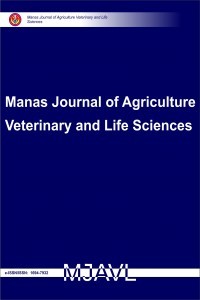Keçiboynuzu Posasının Kimyasal Kompozisyonu, İn-Vitro Sindirilebilirliği, Fenolik Bileşikler ve Antioksidan Aktivitesinin Belirlenmesi
Antioksidan, fenolik bileşikler, in-vitro sindirilebilirlik, , keçiboynuzu posası, metabolik enerji
Determination of Chemical Composition, In-Vitro Digestibility, Phenolic Compounds and Antioxidant Activity of Carob Pulp
antioksidan, fenolik bileşikler, in-vitro sindirilebilirlik, keçiboynuzu posası, metabolik enerji,
___
- Açar Z, Öztürk M, Keleş G 2015. Buğday, Mısır ve karabuğday samanları içeren rasyonlarla beslenen dişi tokluların performanslarının belirlenmesi. Turkish JAF Sci Tech. 3:59-62.
- Albayrak S, Sağdıç O, Aksoy A. Bitkisel ürünlerin ve gıdaların antioksidan kapasitelerinin belirlenmesinde kullanılan yöntemler. Erciyes Üniv Fen Bil Enst Derg 2010; 26(4):401-409.
- ANKOM, 2020, Ankom Technology Method 3. İn-vitro True Digestibility using the DAISYIIIncubator.https://www.ankom.com/sites/default/files/document-files/Method_3_Invitro_D200_D200I.pdf/ 02.02.2020.
- AOAC 2006. Official Methods of Analysis, 18th edn. Association of Official Analytical Chemists, Inc., Arlington, VA.
- Arthington J D, Kunkle WE, Martin AM 2002. Citrus pulp for cattle. Vet Clin Food Anim.18: 317-326.
- Avvallone R, Plessi M, Baraldi M, Monzari A 2015. Determination of chemical composition of carob (Cerationia siliqua): proteins, fat, carbohydrates and tannins. J Food Compost Anal. 10:166-172.
- Ayaz AF, Torun H, Glew HR, et al. 2009. Nutrient content of carob pod (Ceratonia siliqua L.)flour prepared commercially and domestically. Plant Foods Hum Nutr. 64:286-292.
- Battle T, Tous J 1997. Carob Tree (Ceratonia siliqua L.) Promoting the conservation and use of underutilized and neglected crops 17, International Plant Genetic Resources Institute, Via Delle Sette Chiese, 142, 00145 Rome, Italy, 91.
- Bekir J, Mars M, Souchard JP, Bouajila J 2013. Assesment of antioxidant, anti- inflammatory, anti- cholinesterase and cytotoxic activities of pomegranate ( Punica granatum ) leaves. Food and Chemical Toxicology. 55: 470-475.
- Chumpawadee S 2009. Degradation characteristic of tomato pomace, soybean hull and peanut pod in the rumen using nylon bag technique. Pak J Nutr 8:1717-1721.
- Contreras-Calderón J, Calderón-Jaimes L, Guerra-Hernández E, García-Villanova B 2011. Antioxidant capacity, phenolic content and vitamin C in pulp, peel and seed from 24 exotic fruits from Colombia. Food Res Int. 44: 2047–2053.
- Czerkawski JW, Breckenridge G 1977. Design and development of long-term rumen simulation technique (RUSITEC). Br J Nutr. 38:271–384.
- Dimins F, Kuka P Augspole I 2010. Characterısatıon of honey antıoxıdatıve propertıes, International conferance of food Innova, 28-29- Oct, Latvia.
- El-Shatnaw MKJ, Reifej KI 2015. Chemical composition and livestock ingestion of carob (Ceratonia siliqua L.) seeds. J Range Manage. 54:669–673.
- Erdem F, Cetinkaya N 2016. Digestibility of Juncus acutus and its effects on ruminal cellulolytic bacteria, Italian J Anim Sci. 15:1: 69-75. DOI: 10.1080/1828051X.2016.1139327.
- Filik G, Kutlu HR 2017. Determination of nutrient values in drying citrus pulp with alternative drying methods. Anim Husb Dairy Vet Sci. 1(4): 2-3.
- Grados N, Cruz G 1996.. New approaches to industrialization of Algarrobo (Prosopis pallida) pods in Peru. In : Prosopis. Semiarid Fuelwood and Forage Tree; Building Consensus for the Disenfranchised. (Eds.) P.Felker and J.Moss. Center for Semi-Arid Forest Resources.
- Karabulut A, Canbolat O and Kamalak A 2006. Evaluation of carob, Ceratonia siliqua pods as a feed for sheep. Livest Res Rural Dev. 18(7):104.
- Karkacıer M, Artık N 1995. Keçiboynuzunun (Ceratonia siliqua L.) fiziksel özellikleri, kimyasal bileşimi ve ekstraksiyon koşulları. Gıda Teknol Dern. 3:131-136.
- Kirchgessener M, Kellner RJ, Roth FX 1977. Zur Schatzung des futterwertes mittels rohfaser und der Zellwandfraktionen der detergentien-analyse. Landwirtsch. Forsch. 30: 245-250.
- Maritim AC, Sanders RA, Watkins JB 2003. III. Diabetes, oxidative stress, and antioxidants:A review. J Biochem Molec Toxicol. 7(1):24-38. DOI:10.1002/jbt.10058.
- Orhan IE, Sunta IP, Akkol EK 2011. In-vitro neuroprotective effects of the leaf and fruit extracts of Juglans regia L.(walnut) through enzyme linked to Alzheimer’s disease and antioxidant activity. Inter J Food Sci and Nutr. 62(8): 781-786.
- Otles S, Yalçın B 2012. Phenolic compounds analysis of root, stalk, and leaves of nettle. The Scientific World Journal. 12:1-2. doi:10.1100/2012/564367.
- Owena RW, Haubnera R, Hullb WE, et al. 2003. Isolation and structure elucidation of the major individual polyphenols in carob fibre. Food and Chem Toxicology. 41(12):1727-1738.
- Özyürek M, Güçlü K, Apak R 2011. The main and modified CUPRAC methods of antioxidant measurement. Trends in Analy Chem. 30(4):652-664.
- Pazar F, Alper Y 2016. Keçiboynuzu (Ceratonia siliqua L.) meyvesi ve sağlık. Akademik Gıda. 14 (3): 333-337.
- SAS 2007. Statistical Software, Campus Drive. Cary, North Caroline 27513, USA.
- Savrunlu M, Denek N 2016. Farklı seviyelerde yaş domates posası ilavesi ile hazırlanan mısır silajının kalitesinin araştırılması. Harran Üniv Vet Fak Derg. 5:5-11.
- Socaci SA, Farcas AC, Vodnar DC, Tofana M 2017. Food wastes as valuable sources of bioactive molecules. In: Naofumi Shiomi, (Ed), Superfood and Functional Food- The Development of Superfoods and Their Roles as Medicine. Rijeka, Croatia: InTech; pp. 75-93.
- TUİK 2019 “2019 yılı keçiboynuzu üretim miktarı” https://www.drdatastats.com/illere-gore-turkiyede-meyve-uretimi-ton-2019-yili-keciboynuzu-harnup/30.05.2019.
- Van Soest PJ, Robertson JD, Lewis BA 1991. Methods for dietary fibre, neutral detergent fibre and non-starch polysaccharides in relation to animal nutrition. J Dairy Sci. 74: 3583-3597.
- Yalçınkaya MY, Baytok E, Yörük MA 2012. Değişik meyve posası silajlarının bazı fiziksel ve kimyasal özellikleri. Erciyes Üniv Vet Fak Derg. 9(2):95-106.
- Yurdagel Ü, Teke İ 1985. Keçiboynuzu meyvesinin kavrulması ile oluşan renk değişimlerinin araştırılması. Gıda Teknolojisi Derneği. 10(1): 39-42.
- ISSN: 1694-7932
- Yayın Aralığı: 2
- Başlangıç: 2013
- Yayıncı: KIRGIZİSTAN-TÜRKİYE MANAS ÜNİVERSİTESİ
Hüseyin DEMİRBAŞ, Nurcan ÇETİNKAYA
Kan Beyin Bariyeri ve İlaç Geçiş Modulasyonu
Yerfıstığında Çinko Yaprak Gübresi Uygulamasının Verim Üzerine Etkilerinin Belirlenmesi
Ahmet YENİKALAYCI, Mehmet ARSLAN
Ordu’da kivi bitkilerinden izole edilen Fusarium türlerinin tanımlanması ve patojenisitesi
